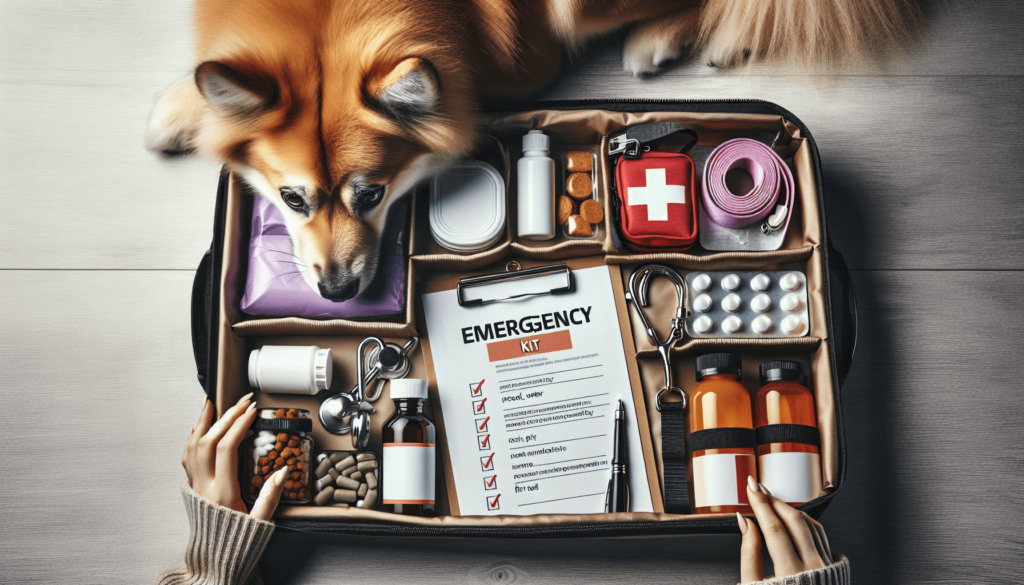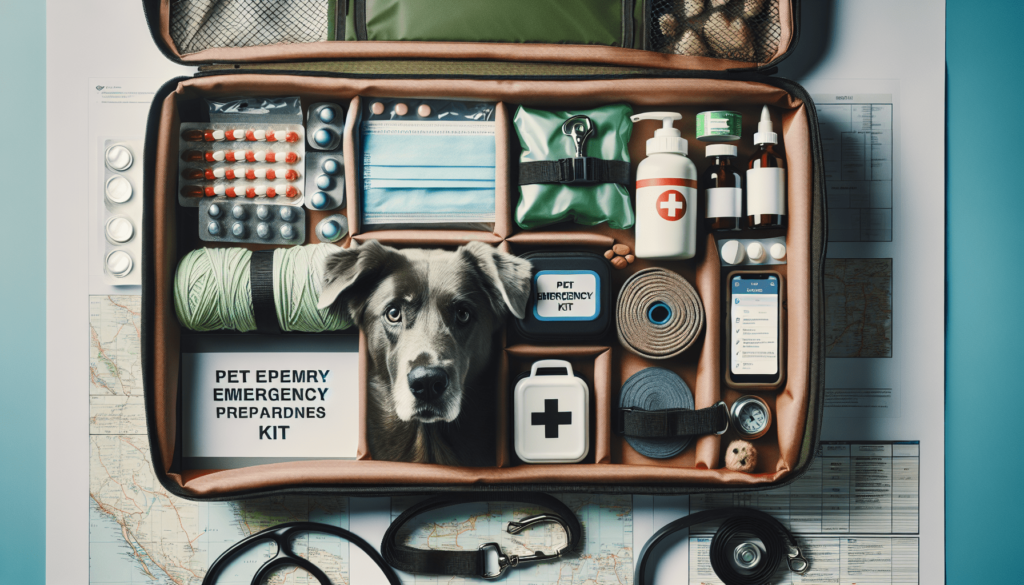Welcome to an informative article on emergency preparedness for pet owners! It’s important to be ready for any unexpected events that may require you to evacuate your home with your furry friend. This article will provide you with essential tips and guidelines to ensure the safety and well-being of your pet during emergencies. From creating a pet emergency kit to establishing a communication plan, you’ll learn everything you need to know to be fully prepared for any situation. So grab a cup of tea, sit back, and let’s dive into how you can best protect your beloved pet in times of crisis.
Emergency Preparedness For Pet Owners
Have you ever thought about what you would do if a disaster struck and you needed to evacuate your home in a hurry with your pets? Being prepared for emergencies is crucial for every pet owner. From natural disasters to unexpected emergencies, having a plan in place can make all the difference for the safety and well-being of your furry friends. In this article, we will dive into the essential steps you need to take to ensure you are ready for any emergency situation that may arise.
Creating an Emergency Kit for Your Pet
One of the first steps you should take as a responsible pet owner is to create an emergency kit for your pet. This kit should contain everything your pet needs to stay safe, healthy, and comfortable during an emergency situation. Some essential items to include in your pet emergency kit are:
- Food and water: Pack at least a three-day supply of your pet’s food and water in sealed, waterproof containers.
- Medications: Include any medications your pet takes regularly, as well as a copy of their medical records.
- First aid supplies: Have a pet first aid kit on hand with bandages, gauze, antiseptic wipes, and any other supplies your pet may need in case of an injury.
- Extra leash and collar: Make sure you have an extra leash and collar in case your pet’s current ones get lost or damaged.
- Comfort items: Pack a favorite toy, blanket, or other comfort items that will help keep your pet calm during a stressful situation.
- Copies of important documents: Keep copies of your pet’s identification, vaccination records, and any other essential documents in a waterproof container.
- Updated photo: Include an updated photo of your pet in case they get lost during an evacuation.
By having an emergency kit prepared and readily accessible, you can ensure that you have everything you need to care for your pet during an emergency.
Planning for Pet-friendly Evacuation
In the event of an evacuation, it is essential to have a plan in place for your pet. Many shelters and evacuation centers do not allow pets, so it is crucial to research pet-friendly evacuation options ahead of time. Here are some steps you can take to prepare for pet-friendly evacuation:
- Research pet-friendly shelters: Find out which shelters in your area allow pets and have a plan in place to evacuate to one of these locations.
- Create a list of pet-friendly hotels: Identify pet-friendly hotels in your area or along your evacuation route where you can stay with your pet if needed.
- Arrange transportation: Make arrangements for transportation for both you and your pet in case you need to evacuate your home quickly.
- Keep your pet carriers handy: Make sure your pet carriers are easily accessible in case you need to evacuate with your pet in a hurry.
By planning ahead and knowing your options for pet-friendly evacuation, you can ensure that your pet stays safe and secure during an emergency.

Ensuring Your Pet’s Identification is Up to Date
One of the most crucial steps you can take to prepare for an emergency is to ensure that your pet’s identification is up to date. In times of crisis, pets can easily get separated from their owners, making it essential to have a reliable form of identification for your pet. Here are some ways you can ensure your pet’s identification is up to date:
- Microchip your pet: Consider having your pet microchipped by your veterinarian. A microchip is a tiny device that is implanted under your pet’s skin and contains a unique identification number that can be scanned by a vet or animal shelter to reunite you with your pet.
- Register your pet’s microchip: Make sure the information linked to your pet’s microchip is up to date with your current contact information.
- Collar and tags: Have a collar with identification tags on your pet at all times, including your name and phone number.
- Update your pet’s identification: If you move or change your contact information, make sure to update your pet’s identification tags and microchip information promptly.
By taking these steps to ensure your pet’s identification is up to date, you can increase the chances of being reunited with your beloved pet in case of an emergency.
Creating a Pet Emergency Plan
Creating a pet emergency plan is crucial for every pet owner. This plan outlines how you will care for your pet during an emergency and ensures that you have everything in place to keep your pet safe. Here are some essential elements to include in your pet emergency plan:
- Emergency contacts: Make a list of emergency contacts, including your veterinarian, local animal shelters, and pet-friendly hotels, in case you need to reach out for help during an emergency.
- Evacuation routes: Familiarize yourself with evacuation routes in your area and have a plan in place for evacuating with your pet quickly and safely.
- Pet care instructions: Write out detailed instructions for caring for your pet, including feeding schedules, medications, and any special needs your pet may have.
- Backup caretaker: Identify a trusted friend, neighbor, or family member who can care for your pet in case you are unable to do so during an emergency.
By having a pet emergency plan in place, you can rest assured that you are prepared to care for your pet in any emergency situation that may arise.

Staying Informed About Potential Emergencies
Another crucial step in emergency preparedness for pet owners is staying informed about potential emergencies in your area. Whether natural disasters like hurricanes, wildfires, or floods are common in your region or unexpected emergencies can occur at any time, being aware of potential threats can help you prepare in advance. Here are some ways to stay informed about potential emergencies:
- Sign up for emergency alerts: Register for emergency alerts with your local government or emergency management agency to receive notifications about potential emergencies in your area.
- Follow local news: Stay up to date with local news sources to learn about any developing emergencies in your region.
- Join community groups: Join community groups or forums where you can connect with other pet owners and share information about emergency preparedness.
- Attend training sessions: Consider attending training sessions or workshops on pet emergency preparedness to learn more about how to keep your pet safe during an emergency.
By staying informed about potential emergencies in your area, you can take proactive steps to prepare for any situation that may arise and keep your pet safe.
Practice Your Emergency Plan
Once you have created an emergency plan for your pet, it is essential to practice it regularly to ensure that you can execute it effectively during an actual emergency. Practicing your emergency plan helps you identify any areas that may need improvement and ensures that you and your pet are prepared for any situation that may arise. Here are some tips for practicing your pet emergency plan:
- Conduct mock evacuations: Set aside time to practice evacuating your home with your pet, including gathering your emergency kit, loading your pet into their carrier, and following your evacuation route.
- Review your pet’s identification: Double-check that your pet’s identification tags and microchip information are up to date, and practice locating this information quickly.
- Test your communication plan: Reach out to your emergency contacts to ensure that everyone is reachable and aware of their role in your pet’s emergency plan.
By practicing your emergency plan regularly, you can ensure that you are prepared to care for your pet effectively during an emergency and provide the best possible outcome for their safety and well-being.
Conclusion
Being prepared for emergencies as a pet owner is crucial to ensure the safety and well-being of your furry friends. By creating an emergency kit, planning for pet-friendly evacuation, ensuring your pet’s identification is up to date, creating a pet emergency plan, staying informed about potential emergencies, and practicing your emergency plan, you can be ready for any situation that may arise. Remember, your pet relies on you to keep them safe and secure during emergencies, so taking the time to prepare can make all the difference in a potentially life-threatening situation. Stay informed, stay prepared, and keep your pets safe.

